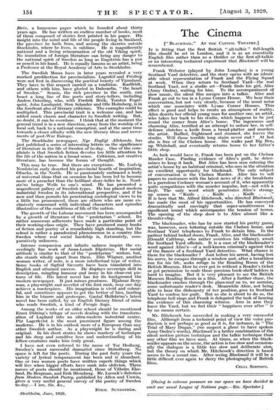The Cinema
[" BLACKMAIL." AT TILE CAPITOL THEATRE.]
IT is fitting that the first British " all-talkie " full-length film should be set in London, and it is as an essentially English film rather than as a thriller or the first all-talkie or an interesting technical experiment that Blackmail will be remembered.
Frank Webster (played by John Longden) is a young Scotland Yard detective, and the story opens with an admir- able silent representation of Frank and the Flying Squad at work. When they return to Scotland Yard—the real Scotland Yard, not a studio set—Frank finds his girl, Alice (Army Ondra), waiting for him. To the accompaniment of slow music, the silent film merges into a talkie. Alice and Frank go out to tea in a Lyons Corner House. We hear their conversation, but not very clearly, because of the usual noise which one associates with Lyons Corner Houses. This effect is good and helps to create an atmosphere of reality. Alice deserts her official young man for another one, an artist, who takes her back to his studio, which happens to be just round the corner from Alice's home. The ingenuous and charming Alice, terrified at an attempt to seduce her, in self- defence clutches a knife from a bread-platter and murders the artist. Baffled, frightened and stunned, she leaves the studio. Will those terrible long stairs never end ? At last she is free of the Chelsea house. She walks past Big Ben, up Whitehall, and eventually returns home to her father's little shop.
As luck would have it, Frank has been put on the Chelsea Murder Case. Finding evidence of Alice's guilt, he deter- mines to keep it back. But Alice has been seen entering the artist's house by an habitual criminal, who sees in the situation an excellent opportunity for blackmail. The only subject of conversation is the Chelsea Murder. Alice has to sell papers to customers with the latest news of it ; she breakfasts to a garrulous Cockney woman's account of it, who apparently quite sympathizes with the murder impulse, but—not with a knife. The only word which penetrates Alice's strung- up senses is Knife . . . Knife . . . Knife . . . ' It is here that Mr. Alfred Hitchcock, who directed Blackmail, has made the most of his opportunities. He has conveyed dramatically and movingly that super-sensitiveness to significant sound which accompanies the tension of terror. The opening of the shop door is to Alice almost like a thunder-clap.
The blackmailer, who has by now started his pretty game, was, however, seen loitering outside the Chelsea house, and Scotland Yard telephones to Frank to detain him. In the parlour behind locked doors, Frank, Alice, and the blackmailer (Donald Calthrop, who rather overdoes his villainy), await the Scotland Yard officials. It is a case of the blackmailer's word against Alice's—of a well-known criminal's against that of the fiancee of a Scotland Yard detective. What chance is there for the blackmailer ? Just before his arrest, having lost his nerve, he escapes through a window and, after a breathless run for his life, seeks refuge in the Reading Room of the British Museum. How he ever got in without a Reader's ticket or got permission to scale those precious book-shelf ladders is hard to imagine. But it is very pleasant to see the British Museum Reading Room in a film. After a further chase, the blackmailer crashes through the glass-roof on to, we surmise; some unfortunate reader's desk. Meanwhile Alice, not being able to bear the dishonesty of her position, goes to Scotland Yard to confess her guilt. But as she is about to do so, the telephone bell rings and Frank is delegated the task of hearing the evidence of this charming witness. Arm in arm they leave the Yard, but we feel their " happiness ever after " is by no means certain.
Mr. Hitchcock has succeeded in making a very successful film. Although from a technical point of view the voice pro- duction is not perhaps as good as it is, for instance, in " The Trial of Mary Dugan," (we suspect a ghost to have spoken Anny Ondra's words), Blackmail is a better combination of the silent motion picture technique and the talkie technique thari any other film we have seen. At times, as when the black- mailer appears on the scene, the action is too slow and occasion- ally the dialogue is a little too slow and deliberate also but the theory on which Mr. Hitchcock's direction is based seems to be a sound one. After seeing Blackmail it will be a little difficult ever again to decry the photography of British films.
CELIA SIMPSON.


































 Previous page
Previous page